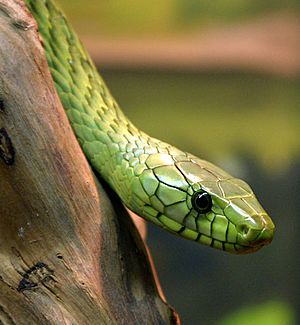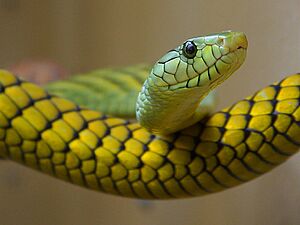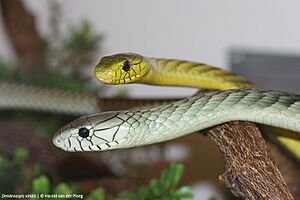Western green mamba facts for kids
Quick facts for kids Western green mamba |
|
|---|---|
 |
|
| Conservation status | |
| Scientific classification | |
| Genus: |
Dendroaspis
|
| Species: |
viridis
|
 |
|
| Dendroaspis viridis range | |
| Synonyms | |
|
|
The western green mamba (Dendroaspis viridis) is a long, thin, and very venomous snake. It belongs to the mamba family, called Dendroaspis. An American scientist named Edward Hallowell first described this snake in 1844.
Western green mambas are quite large. They mostly live in trees, moving quickly and gracefully. They can also come down to the ground to hunt for food. Their diet includes small animals like rodents.
This snake is usually shy and quick. It lives mainly in the tropical rainforests and woodlands along the coast of western Africa. Its venom is very strong and works fast. It affects the nerves and heart. Some people say these snakes are not very aggressive. Others say they get very nervous and might attack if they feel trapped. It's rare for them to bite humans compared to other snakes in their area. However, if a bite happens, it can be very serious. The symptoms appear quickly and can be life-threatening.
Contents
Understanding the Western Green Mamba's Name
The western green mamba was first described in 1844. It was named Leptophis viridis by Edward Hallowell. He was an American scientist and doctor. The word viridis means "green" in Latin.
Later, in 1852, Hallowell described another snake. He called it Dinophis hammondii. This snake was also a western green mamba. A Belgian-British zoologist named George Albert Boulenger later realized they were the same species.
For a while, the genus name was spelled wrong as Dendraspis. But in 1936, a Dutch scientist named Leo Brongersma corrected it to Dendroaspis. Scientists have studied the venom of all mambas. They found that the western green mamba is closely related to Jameson's mamba. People also call this snake the West African green mamba.
What Does a Western Green Mamba Look Like?
The western green mamba has a long, thin body and a long, narrow tail. Adult snakes are usually between 1.4 meters (4.6 feet) and 2.1 meters (6.9 feet) long. Some can even reach 2.4 meters (7.9 feet). Its head is long and thin. It has medium-sized eyes with round pupils and yellowish-brown eyes.
When this snake feels threatened, it can flatten its neck. This makes it look a bit like it has a small hood. The snake is bright green. Its color fades to yellow or orange near the tail. Its scales have dark edges, which makes the snake look like it has a net pattern.
Sometimes, people confuse the western green mamba with other green snakes. These include green bushsnakes or the boomslang.
Scales: A Snake's Unique Fingerprint
The number and pattern of scales on a snake's body help scientists identify its species. The western green mamba has 13 rows of long, thin scales along its back. This is fewer than other similar snakes. Each of these scales is twice as long as the scales on its belly.
It has between 211 and 225 belly scales. It also has 105 to 128 divided scales under its tail. The scale near its vent (where waste leaves its body) is also divided. Around its mouth, it has 7 to 9 scales above and 9 to 10 scales below.
Where Do Western Green Mambas Live?
The western green mamba lives in West Africa. Its home stretches from Gambia and southern Senegal to Benin. This includes countries like Guinea-Bissau, Guinea, Sierra Leone, Liberia, Côte d'Ivoire (Ivory Coast), Ghana, and Togo. It is common in Togo.
These snakes mostly live in coastal tropical rainforests, thick bushes, and woodlands. Most sightings are in continuous forests. However, some have been seen in isolated forests in Gambia and Guinea-Bissau. They can even live in areas where trees have been cut down, as long as there are still enough hedges and thick bushes. You might find them in some green suburbs, towns, and parks. They usually live where there is more than 1,500 mm (59 inches) of rainfall each year.
Protecting the Western Green Mamba
The western green mamba is listed as "Least Concern" by the IUCN Red List of Threatened Species. This means it's not currently in great danger. This is because it lives in many places and its population is stable. It can also adapt to different habitats.
However, the places where it lives are becoming broken up. Even though it's not on the CITES list, people do collect and sell western green mambas. They are one of the more expensive African snake species.
Western Green Mamba Behavior
The western green mamba is mostly active during the day. It spends most of its time high up in the trees. Sometimes, it comes down to the ground. When it wants to sleep, it finds tree branches with lots of leaves for cover. If it meets a human, it usually tries to get away. The oldest western green mamba recorded lived for 18.7 years in captivity.
Reproduction and Life Cycle
The female western green mamba lays a clutch of 6 to 14 eggs.
What Do Western Green Mambas Eat?
Western green mambas usually hunt in trees, but they can also hunt on the ground. They eat birds and small mammals. This includes rodents and squirrels.
Their natural enemies include birds that hunt, like raptors. Larger mammals can also be a threat.
Understanding Western Green Mamba Venom
The World Health Organization considers the western green mamba a snake of medical importance. However, bites from this snake are rare because people don't often encounter them. If someone is bitten, symptoms appear very quickly, often within 15 minutes or less. The venom spreads fast and causes serious symptoms rapidly. This quick action is special to mamba bites.
Common symptoms of a western green mamba bite include pain and swelling where the bite happened. Sometimes, the tissue can be damaged. Other symptoms include trouble with coordination, headache, feeling sleepy, difficulty breathing, dizziness, low blood pressure, diarrhea, and paralysis. If not treated quickly, new and more serious symptoms appear fast. All symptoms get worse, and the person can die because their breathing muscles become paralyzed. Bites with venom can be deadly very quickly, sometimes in just 30 minutes.
The venom of the western green mamba is mainly made of toxins that affect the nerves. It also has toxins that affect the heart and muscles. The strength of the venom can change. This depends on things like what the snake eats, where it lives, and its age.
Treatment for a Western Green Mamba Bite
Because the venom works so quickly, urgent medical help is needed for a western green mamba bite. The first thing to do is apply a pressure bandage to the bite area. The person who was bitten should move as little as possible. Then, they need to get to a hospital or clinic very fast.
Because the venom affects the nerves, a tight band (tourniquet) might help. Sometimes, a tetanus shot is given. But the most important treatment is to give the right antivenom.
See also
 In Spanish: Mamba verde occidental para niños
In Spanish: Mamba verde occidental para niños




